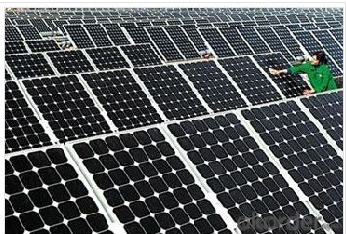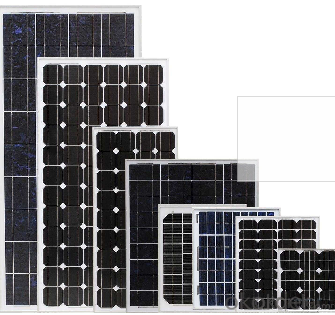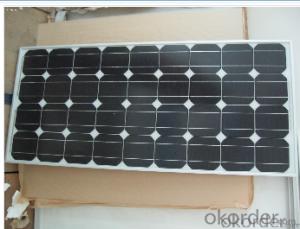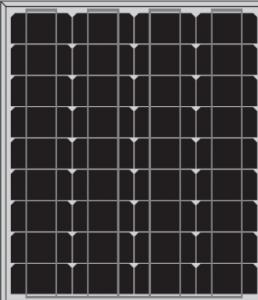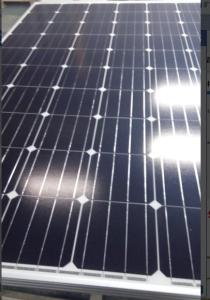Solar Panels Las Vegas NV with High Quality of CNBM
- Loading Port:
- China main port
- Payment Terms:
- TT OR LC
- Min Order Qty:
- 1 pc
- Supply Capability:
- 10000000 pc/month
OKorder Service Pledge
OKorder Financial Service
You Might Also Like
Product Description:
PERFORMANCE
- High effi ciency, multicrystalline silicon solar cells with high transmission
and textured glass deliver a module effi ciency of up to 16.0%,
minimizing installation costs and maximizing the kWh output of your
system per unit area.
- Tight positive power tolerance of 0W to +5W ensures you receive
modules at or above nameplate power and contributes to minimizing
module mismatch losses leading to improved system yield.
- Top ranking in the “TÜV Rheinland Energy Yield Test” and the
“PHOTON Test” demonstrates high performance and annual energy
production.
RELIABILITY
- Tests by independent laboratories prove that modules:
Fully conform to certifi cation and regulatory standards.
Withstand wind loads of up to 2.4kPa and snow loads of up to
5.4kPa, confi rming mechanical stability.
Successfully endure ammonia and salt-mist exposure at the highest
severity level, ensuring their performance in adverse conditions.
- Manufacturing facility certifi ed by TÜV Rheinland to ISO 9001:2008,
ISO 14001:2004 and BS OHSAS 18001:2007.
WARRANTIES
- 10-year limited product warranty1.
- Limited power warranty1: 10 years at 91.2% of the minimal rated power
output, 25 years at 80.7% of the minimal rated power output.
1In compliance with our Warranty Terms and Conditions.
QUALIFICATIONS & CERTIFICATES
IEC 61215, IEC 61730, MCS, CE, ISO 9001:2008, ISO 14001:2004, BS OHSAS
18001:2007, PV Cycle, SA 8000
ELECTRICAL PERFORMANCE
Electrical parameters at Standard Test Conditions (STC)
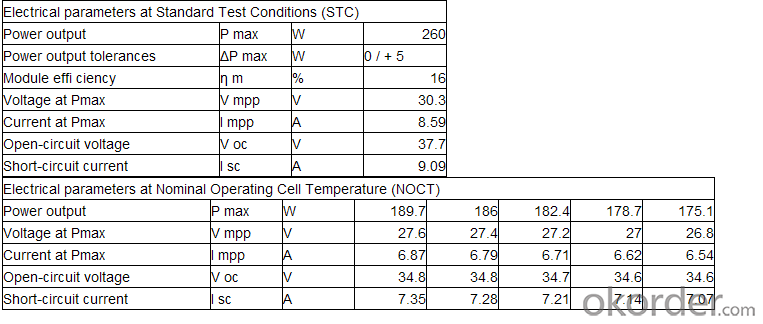

- Q: Can solar panels be used to power a factory?
- Yes, solar panels can be used to power a factory. Solar panels generate electricity by converting sunlight into energy, which can be used to power various operations in a factory. However, the feasibility and effectiveness of using solar panels to power a factory would depend on factors such as the size of the factory, energy requirements, available sunlight, and the capacity of the solar panel system.
- Q: Hi, I want to put some solar light in my yard, and wondering if a 00w solar panel could work for a few 3w dc lights....do i need a battery so they run at night, if so how many lights do u think i can run/ also i see elading solar light
- No longer just any bulb will work on DC power. Any light bulb that's for 0voltage won't work on DC energy due to the fact that the element has too much resistance for a DC vigor provide to create ample heat to generate mild from the aspect. Nonetheless the do make mild bulbs that are designed to function on a DC energy supply and i might extremely recomend making use of the proper bulb with the proper vigour provide. Purchase some 2volt bulbs to be dependable......
- Q: Can solar panels be installed on a farm or agricultural facility?
- Yes, solar panels can be installed on a farm or agricultural facility. In fact, they are increasingly being used in such settings due to their numerous benefits. Solar panels can help farmers and agricultural facilities reduce energy costs, become more self-sufficient, and promote sustainability by harnessing renewable energy from the sun. Additionally, solar panels can be installed on different structures like rooftops, barns, or open fields, making them a versatile option for farms and agricultural facilities.
- Q: Given that I am going to purchase a solar panel to charge my cell phones and other gadgets, I would like to know what the ammount of power produced by a 6 Watt solar panel is under regular circumstances. (IE partial sun, full sun, cloudy)
- That site tells you somewhat about the cost of solar panels and their MAXIMUM output. Now some who have these panels claim output, in daily terms, 8 times as great as maximum output, which says they are counting on 8 hours of effective sunlight. In California Desert that is sound. You will discover that Ontario Power grid is planning for 3 hours to 4 hours of maximum output . Based on that 3 to 4 hours of maximum output, it would take close to 20 years to recover your cost at the price Ontario pays for solar power. The deal locks you in so that you can not get more money as electricity prices go up, and do not lose if electricity prices go down over that 20 years.
- Q: if I have a battery bank of of 6 L-6 Trojan batteries, 6V 390AH, wired in series parallel to give me 2V at 70AH (or 4,040WH) what kind of solar panels should I purchase assuming I have 8 hours of sunlight, a solar tracking system and I want to make sure I can fully recharge my batteries everyday if i use up all the power every night?i understand there are efficiency issues to consider which i have not calculated in yet. thanks.
- If okorder /... yet, it's worth browsing the off-grid section. 8 peak equivalent sun hours a day on average is very achievable with tracking, but are you sure you really want to spend on tracking? It's a lot of trouble and expense - might be cheaper just to get more panels. Also be aware that when you have a lead-acid battery bank capable of (say) 000 Ah, that is the capacity that the batteries could supply as a one-shot deal. If you ever took that much from them, they would be ruined. Typically, you would try to take only 20% of the capacity before recharging, although some batteries let you take 50%, with reduced life. Have you considered wiring the batteries as 36 volts? There would be more efficiency, and less problems with equalizing the batteries when charging. Unless 2 volts is really the output that you need most. Sorry to redirect you, but I can't recommend that forum too highly. Lots of considerations.
- Q: Can solar panels be used to power a farm?
- Yes, solar panels can be used to power a farm. By harnessing the sun's energy, solar panels can generate electricity that can be used to power various farm operations such as pumps, irrigation systems, lighting, and even machinery. This renewable energy source offers a sustainable and cost-effective solution for farmers looking to reduce their reliance on traditional power sources and reduce their carbon footprint.
- Q: I'm making a model of a solar photovoltaic tower for a school project. I need a way to store energy, and we thought about using capacitors (mainly because of our somewhat limited funding). The tower will have a small photovoltaic panel (around the size of a laptop keyboard with number pad) and some (around 50) quot;heliostats(just the mirrors, no moving parts). What kind of capacitors should i use? and would a capacitor bank be better? i am getting confused with all those uF, pF and can't see the difference.Thanx in advance
- There okorder /
- Q: Are the solar panels on the roof just a gimik to get all the tree huggers to buy it, or are they actually a good, efficent design?
- treehuggers already want priuses. the solar panel is meant to run an electric ac system that cool's the prius if the car gets too hot inside. its nice, but personaly, i'd rather have it charge the battery.
- Q: Simplfy it so i can understand pls and put it in stages such as . sun hits solar panel plsHow many different types of solar panels are there?
- The term solar panel is best applied to a flat solar thermal collector, such as a solar hot water or air panel used to heat water, air, or otherwise collect solar thermal energy. But 'solar panel' may also refer to a photovoltaic module which is an assembly of solar cells used to generate electricity. In all cases, the panels are typically flat, and are available in various heights and widths. An array is an assembly of solar-thermal panels or photovoltaic (PV) modules; the panels can be connected either in parallel or series depending upon the design objective. Solar panels typically find use in residential, commercial, institutional, and light industrial applications. Solar-thermal panels saw widespread use in Florida and California until the 920's when tank-type water heaters replaced them. A thriving manufacturing business died seemingly overnight. However, solar-thermal panels are still in production, and are common in portions of the world where energy costs, and solar energy availability, are high. Recently there has been a surge toward large scale production of PV modules. In parts of the world with significantly high insolation levels, PV output and their economics are enhanced. PV modules are the primary component of most small-scale solar-electric power generating facilities. Larger facilities, such as solar power plants typically contain an array of reflectors (concentrators), a receiver, and a thermodynamic power cycle, and thus use solar-thermal rather than PV.
- Q: I want to replace my electricity with solar and wind. I live just right outside the city, the roof about 000 square feet. How many windmills/solar panels would it take to get me off the power grid?
- Insolation, okorder okorder /... that are 420x420x25 mm so each unit is about .764 m3. If you used these to cover 500 sq ft then you would need (46.45/.764=) 263 of these panels at a cost of ($09.95 x 263=) about $28,953 plus wiring, plus brackets, plus an inverter, plus batteries, plus a battery management system and any labor or your time. Best of luck with it.
Send your message to us
Solar Panels Las Vegas NV with High Quality of CNBM
- Loading Port:
- China main port
- Payment Terms:
- TT OR LC
- Min Order Qty:
- 1 pc
- Supply Capability:
- 10000000 pc/month
OKorder Service Pledge
OKorder Financial Service
Similar products
Hot products
Hot Searches
Related keywords



